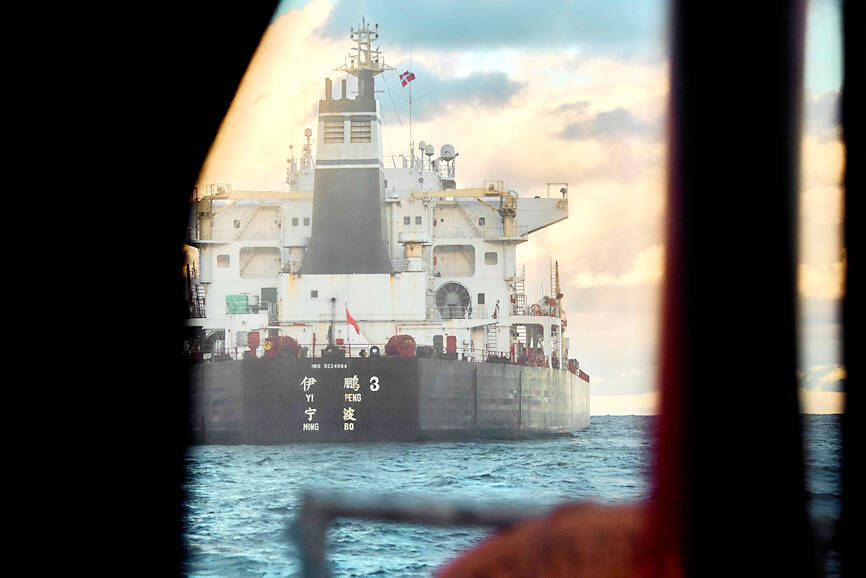Swedish Prime Minister Ulf Kristersson yesterday said that Stockholm wanted a Chinese ship, anchored off Denmark after two Baltic Sea cables were cut, to move to Swedish waters to aid an investigation.
Kristersson told a morning press conference that Sweden had “been in contact with the ship and with China, and have stated that we want the ship to move towards Swedish waters.”
He added that it was not an “accusation,” but aimed to “figure out what has happened.”

Photo: AFP
Sections of two telecom cables were cut on Nov. 17 and 18 in Swedish territorial waters of the Baltic Sea. The Yi Peng 3 sailed over the cables around the time they were severed, according to ship tracking sites, although there is nothing to indicate that it was involved in the incidents.
Swedish and Finnish police have opened investigations and European officials have said they suspect “sabotage” linked to Russia’s invasion of Ukraine.
The Kremlin has rejected the comments as “absurd” and “laughable.”
The Yi Peng 3 has remained anchored in the narrow Kattegat strait between Sweden and Denmark.
The Chinese Ministry of Foreign Affairs has denied any responsibility in the matter.
Denmark’s navy on Wednesday last week said it was shadowing the vessel, which is in international waters. Sweden’s coast guard joined it on Saturday.
Early on Nov. 17, the Arelion cable running from the Swedish island of Gotland to Lithuania was damaged. The next day, the C-Lion 1 submarine cable connecting Helsinki and the German port of Rostock was cut south of Sweden’s Oland island, about 700km from Helsinki.
Tensions have mounted around the Baltic Sea since Russia’s invasion of Ukraine in February 2022.
In September 2022, a series of underwater blasts ruptured the Nord Stream pipelines that carried Russian gas to Europe, the cause of which has yet to be determined.
In October last year, an undersea gas pipeline between Finland and Estonia was shut down after it was damaged by the anchor of a Chinese cargo ship.

DEATH CONSTANTLY LOOMING: Decades of detention took a major toll on Iwao Hakamada’s mental health, his lawyers describing him as ‘living in a world of fantasy’ A Japanese man wrongly convicted of murder who was the world’s longest-serving death row inmate has been awarded US$1.44 million in compensation, an official said yesterday. The payout represents ¥12,500 (US$83) for each day of the more than four decades that Iwao Hakamada spent in detention, most of it on death row when each day could have been his last. It is a record for compensation of this kind, Japanese media said. The former boxer, now 89, was exonerated last year of a 1966 quadruple murder after a tireless campaign by his sister and others. The case sparked scrutiny of the justice system in

The head of Shin Bet, Israel’s domestic intelligence agency, was sacked yesterday, days after Israeli Prime Minister Benjamin Netanyahu said he no longer trusts him, and fallout from a report on the Oct. 7, 2023, Hamas attack. “The Government unanimously approved Prime Minister Benjamin Netanyahu’s proposal to end ISA Director Ronen Bar’s term of office,” a statement said. He is to leave his post when his successor is appointed by April 10 at the latest, the statement said. Netanyahu on Sunday cited an “ongoing lack of trust” as the reason for moving to dismiss Bar, who joined the agency in 1993. Bar, meant to

DITCH TACTICS: Kenyan officers were on their way to rescue Haitian police stuck in a ditch suspected to have been deliberately dug by Haitian gang members A Kenyan policeman deployed in Haiti has gone missing after violent gangs attacked a group of officers on a rescue mission, a UN-backed multinational security mission said in a statement yesterday. The Kenyan officers on Tuesday were on their way to rescue Haitian police stuck in a ditch “suspected to have been deliberately dug by gangs,” the statement said, adding that “specialized teams have been deployed” to search for the missing officer. Local media outlets in Haiti reported that the officer had been killed and videos of a lifeless man clothed in Kenyan uniform were shared on social media. Gang violence has left

‘HUMAN NEGLIGENCE’: The fire is believed to have been caused by someone who was visiting an ancestral grave and accidentally started the blaze, the acting president said Deadly wildfires in South Korea worsened overnight, officials said yesterday, as dry, windy weather hampered efforts to contain one of the nation’s worst-ever fire outbreaks. More than a dozen different blazes broke out over the weekend, with Acting South Korean Interior and Safety Minister Ko Ki-dong reporting thousands of hectares burned and four people killed. “The wildfires have so far affected about 14,694 hectares, with damage continuing to grow,” Ko said. The extent of damage would make the fires collectively the third-largest in South Korea’s history. The largest was an April 2000 blaze that scorched 23,913 hectares across the east coast. More than 3,000